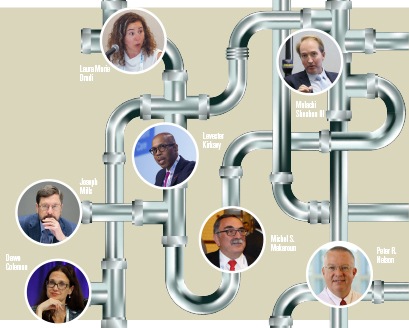
The Vascular Annual Meeting (VAM) E. Stanley Crawford Critical Issues Forum this year probes the problems and the challenges facing the vascular surgery workforce pipeline. The opening day highlight—the domain of the incoming SVS president, Joseph Mills, MD—seeks to unravel the multi-faceted, multi-directional nature of the issues contained within this complex structure.
Joseph Mills describes it as having become something of an overused, one-dimensional trope. For the SVS president-elect, who takes over as president at the close of VAM 2023, the pipeline is far more complex than that: The issues surrounding, feeding into, emerging out of— and, potentially, clogging up—the vascular surgery workforce pipeline are myriad and far more difficult to pin down than to a simple, singular pipe. “The pipeline is not one line,” the professor and chief of vascular surgery at Baylor College of Medicine in Houston, Texas, tells VS@VAM. “It has multiple connections that come from multiple places and go to multiple places.”
That’s why Mills planned this year’s Crawford Forum—traditionally the preserve of the incoming Society president to focus on the direction of vascular surgery—with a title reflecting one of the specialty’s most existential issues: The State and Future of Our Specialty—Extending, Repairing and Maintaining the Vascular Surgery Pipeline. The session will take place in Potomac A/B today (11 a.m.–12:15 p.m.).
The Forum’s panel captures three main areas of focus: sources of future vascular surgeons, the existing workforce, and the distribution of that workforce. To that end, Mills hand-picked six speakers to deal with the issues at hand. Lee Kirksey, MD, from the Cleveland Clinic in Ohio looks at outreach to high school and college students and Malachi Sheahan III, MD, from Louisiana State University in New Orleans, deals with outreach to medical students and residents in training. And while Dawn M. Coleman, MD, from Duke University Medical Center in Durham, North Carolina, will address vascular surgeon wellness, Laura Marie Drudi, MD, from Centre Hospitalier de l’Universite de Montreal in Canada, will discuss solutions for burnout in vascular surgery. Meanwhile, former SVS President Michel S. Makaroun, MD, from University of Pittsburgh Medical Center, is set to hone in on the question of insufficient supply or maldistribution in vascular surgery, as Peter R. Nelson, MD, from the University of Oklahoma in Tulsa, rounds out the panel with a talk on prophylactic measures to improve the workforce crisis.
‘It’s complicated’
Mills wants his colleagues to grasp the complexity of the issues facing the vascular surgery workforce. That is what his lineup of speakers and their topics are set up to elucidate. “The pipeline meme has become a bit of a tired one,” he says. “The pipeline that people traditionally think about—that there are not enough people coming into the pipeline; we need more people to pour out the end of the pipeline—I think it’s much more complicated than that. It’s an interconnected network of pipes, which is how I want to think about this whole problem.”
It’s as the title portends, Mills continues: “Extending, repairing and maintaining the pipeline; so it’s not just a matter of getting more people in so we can get more people out. It’s how we treat the people inside the pipeline to prevent them from clogging or from leaking out of the pipeline. And then how do we supply—think about an irrigation network supplying water to farmland. We have a maldistribution of vascular surgeons, and probably an insufficient supply also, although those two things interact.”
The first two talks—concerning recruitment—are about sparking interest. And it purposely goes beyond what might be thought of as the traditional realms of trainee origin, Mills says. “For years, we took all our trainees from a general surgery program. As the specialty split off, it became obvious we needed to reach out to medical students.”
But to get the right mix, the specialty needs to reach even further back into the pipeline—even middle school students—to try to develop broad interest in medicine, Mills explains. “If you believe—and most of us do—that patients like to see doctors who are like them and understand them, then if you don’t recruit people from smaller and unrepresented communities, and you don’t recruit people who look like your patients, you’re going to perpetuate inequitable access to and distrust in our healthcare delivery system.”
Then there are concerns around maintenance of the existing workforce, and the specter of wellness, burnout and moral injury. That means keeping vascular surgeons in the pipeline so that they don’t retire too early because they get “burned out” amid some of the automated aspects of modern practice, says Mills. “There probably are too few vascular surgeons and a large proportion of us are over 55. If we start retiring earlier, and a large number of our specialists are over 55, that’s going to accentuate the lack of vascular surgeons. What will happen is other specialties will try to fill the gap.”
The other two talks ponder whether there are enough vascular surgeons currently practicing, or if they “are just in the wrong places,” Mills says. “My own take is that it is both.” His theme of a workforce pipeline is not meant to be “the tired” analogy of: “You’ve got to pour more people through to get more people out of the end.” The questions, then, center on: “Are we attracting people from diverse backgrounds,” Mills concludes. “And if we do that, can we solve some of the distribution problems? Texas is an oil state. Pipelines burst and corrode. And they get obstructed. So how do you maintain what you have and, by design, even extend service to areas and people that aren’t being served.”












